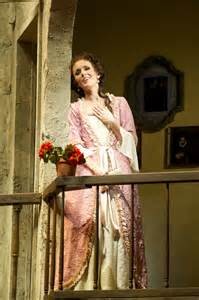As anyone who explores this site can tell, my random thoughts about opera can sometimes be very, very random. I’ve been having one of those thoughts again. With LA in the midst of Figaro Unbound (see my review of UCLA’s I Due Figaro) and Il Barbiere di Siviglia currently playing at the LA Opera, my mind has been drifting toward that particular opera. Namely a particular passage within that opera which, judging by older recordings and reviews used to always be cut: Rosina’s entrance on the balcony, recitative exchange with Bartolo and letter to the Count in Act I, Scene I.
I understand why it was cut. The plot can move along without it, and I’m sure that sometimes it confuses people. If Rosina tosses the Count a note in Scene I, then why in the very next scene, they might ask, does she write another one? It makes sense to me, though: she writes a note asking, “Who are you?” the Count sings his reply in “Se il mio nome,” she starts to sing a romantic response but is interrupted, so she writes the second note to discreetly assure him that she loves him back. I’d ignore the once-standard cut as a misguided relic of a bygone era, except that I find it slightly fascinating. This is our heroine’s entrance. Whether the balcony/letter recitative is included or not changes our first impression of her and affects the way we view her throughout the rest of the opera.
In the uncut score, Rosina gets no grand entrance like Figaro’s or lyrical entrance like the Count’s. Her first lines are simple recitative. Her entrance certainly has a romantic quality, with her appearing on a Juliet-like balcony with a letter for her love, but it’s not overly romantic. Slightly surprising for an ingénue who’s been built up thus far as a classic “flower of beauty” for whom the tenor has been pining day and night under her balcony. What it offers instead of romance is a vivid introduction to her personality. In quick succession we see her fend off Bartolo’s prying with a convincing lie (“What’s that paper?” “The words to a new opera aria”), toss a subtle, witty barb at him via the opera’s supposed title, “The Useless Precaution,” then accidentally-on-purpose drop the note, make Bartolo go down to get it, make the Count grab it before Bartolo can see him, and then, when Bartolo reaches the street, claim the wind blew it away. Right away we see that our heroine is a mental force to be reckoned with.
Her letter, as read by Figaro moments later, is equally revealing. Surprisingly, it isn’t an outpouring of love. Rosina dryly tells her suitor that he’s “aroused [her] curiosity,” then instructs him with utter practicality to wait until Bartolo leaves the house, then find some discreet way to tell her his name, status and intentions. She ends the note by proclaiming herself “willing to do anything to break her chains.” She doesn’t seem head-over-heels in love yet, or if she is, she’s not quite ready to admit it. She’s intrigued by the Count, wants to know more about him, wants to make sure his intentions are pure, and sees him – possibly even more than as a potential true love – as a potential escape from her life of confinement. Only after she hears his reply aria, “Se il mio nome,” does she sing a lyrical, romantic reply from behind the window shutters and fully commit to the role of smitten love interest.
After building her up before we meet her as a classic Juliet-style figure of romance, the uncut score quickly shatters any preconceived notion that Rosina will be a conventional ingénue. Her entrance establishes her as down-to-earth, practical, rebellious and crafty, an “innamorata” with the personality of a “Columbina,” and tells us that, far from being just a damsel to be rescued, she’ll be an equal, scheming partner-in-crime to the men.
When that recitative passage is cut, as it almost always used to be, our first impression is completely different. Her “entrance” is now the lyrical outpouring of love she sings from offstage in reply to the Count’s “Se il mio nome.” We don’t even get to see her until Scene II. Throughout Scene I she remains the mysterious fantasy object of the Count’s love: a disembodied voice wafting romantically from behind a window shutter in sweet surrender to her “Romeo” below.
Of course her crafty, rebellious side isn’t lost in those cut performances of the opera. Her “proper” entrance in the next scene is the gloriously feisty “Una voce poco fa,” and she still plays the same key role in the intrigue throughout. But losing her Scene I appearance gives her role a different frame. Not until Scene II is she anything but an object of male longing. For all we know, she fell for the Count instantly and threw herself into her love with no practical considerations. Nor is there any hint that he excites her less as a person than as a means of escape. She seems more like a conventional lovesick damsel, and her fierce cunning feels secondary to her role as a romantic figure, whereas in the uncut score, those two sides of her are equal.
I suppose that difference in effect might have been another reason why the cut used to be standard. Divas might have preferred the more lyrical, seductive vocal entrance to the uncut score’s plain recitative, not to mention turning “Una voce poco fa” into a grand “proper” entrance aria to rival Figaro’s. Audiences might have felt the same way, for that matter. And in those days before Women’s Lib, I suspect that performers and audiences alike preferred the “sweeter,” more “beautiful” version of Rosina’s entrance and more “romantic” framing of her role. Some of the opera’s early critics – e.g. Stendhal in his Rossini biography – complained about Rosina’s lack of innocence and tenderness, after all. Whereas nowadays she’s applauded as a proto-feminist heroine and the uncut score’s instant impression of down-to-earth craftiness has more appeal. It’s probably no coincidence that back when the cut was standard, Rosina’s role was usually transposed for the higher, more “innocent” and “feminine” soprano voice, while nowadays we usually hear the earthier, more sensual and tomboyish mezzo voice that Rossini intended.
The same feelings probably existed behind another once-standard cut: Rosina’s vengefully agreeing to marry Bartolo and telling him about the elopement plan when she thinks “Lindoro” is unfaithful in Act II. God forbid – they probably thought in the old days – that our lovely, adorable heroine nearly ruin her own life out of pure spite, or that the near-derailment of our heroes’ plans be her fault!
Rosina’s balance between “dolce, amorosa” and “vipera” is innate to her character. But with just one recitative cut, countless productions have shifted her more toward the “dolce, amorosa” side, where Rossini and Sterbini shifted her toward the “vipera” side. And the changing prevalence of that cut (i.e. the increasing lack thereof) seems to reflect changing social attitudes toward uppity women. It’s a fairly small detail, and a fairly random thing to discuss, but still, it’s interesting.





Jordan
March 19th, 2015 at 16:13
Very insightful post here. It is always interesting what cuts do to change one’s perceptions of a character.